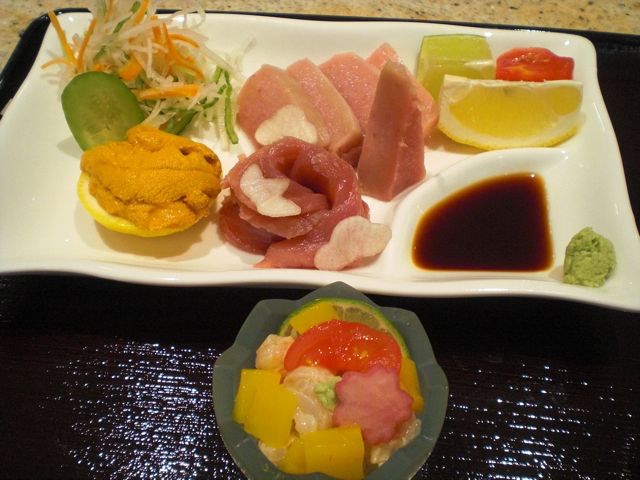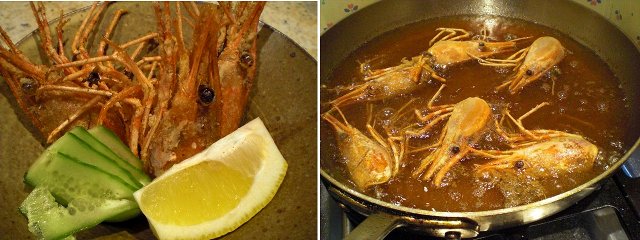As I mentioned before, most of the sake imported from Japan come from large scale producers. Small-scale production sake, especially those with cult followings, are difficult to find here. Even in Japan, there is some hype about the likes of Juyondai sake which maintains the aura of being a special, cult and difficult to find sake. One of the sake connoisseur bloggers in Tokyo appears to have no problem getting or tasting these cult sakes, however. Some time ago, I found one of the Juyondai sake listed on the website of the "Sakaya" of New York. I ordered it on-line and then promptly got a phone call from them saying that it had been sold out almost as soon as they received it. I asked them to contact me as soon as the Juyonday came in next time. A few months later, I got a phone call from Sakaya saying that they had received the shipment. I wanted to order a few bottles but was told there was a limit of one per customer. So, I got one bottle of Juyondai 十四代 along with Isojiman 磯自慢 and Kokuryu 黒龍.
 There are so many different kinds of small batch brews under the name "Juyondai" which were brewed by Takagi sake brewery in Yamagata 山形県高木酒造. It appears that they do not have their own website (I suppose there is no need to advertise). The one I happened to get this time is "bessen junmai-ginjou" 別撰 純米吟醸 made from "Banshu Yamada-nishiki" 播州山田錦, based on the name, I assume it was made from Yamada-nishiki rice grown in a part of Hyougo 兵庫 prefecture. Obviously, this might not have been one of the better brews by Takagi brewery but this is what was available. I had it shipped, while the weather was not too hot, overnight from New York and promptly refrigerated it upon receipt.
There are so many different kinds of small batch brews under the name "Juyondai" which were brewed by Takagi sake brewery in Yamagata 山形県高木酒造. It appears that they do not have their own website (I suppose there is no need to advertise). The one I happened to get this time is "bessen junmai-ginjou" 別撰 純米吟醸 made from "Banshu Yamada-nishiki" 播州山田錦, based on the name, I assume it was made from Yamada-nishiki rice grown in a part of Hyougo 兵庫 prefecture. Obviously, this might not have been one of the better brews by Takagi brewery but this is what was available. I had it shipped, while the weather was not too hot, overnight from New York and promptly refrigerated it upon receipt.

The next day was devoted to anticipation of the full-fledged feast we were planning for the evening. The center piece was, of course the sake complemented with excellent sashimi. The toro was blue fine tuna, chu-toro bordering on Ootoro, and was melt-in-your mouth excellent. I also made an "flower arrangement" of Ko-toro or slightly fatty tuna. The uni was plump luscious golden California uni and it was wonderful as usual.
Since some of the amaebi was big, I made my usual ceviche, this time with lime juice and yuzu juice from the bottle mixed with soy sauce and real wasabi. I added slices of drunken tomato, Champagne mango cubes, and garnished it with "ume-su" 梅酢 seasoned daikon slices cut in a cherry blossom shape.

Of course, I had to serve fried amaebi heads. This cannot go wrong

To pay adequate respect to this sake, I ordered toro, amaebi and uni from Catalina. The first night, after we accumulated all these ingredients for a blow-out gourmet experience, was a Friday. Since we did not have time for proper preparation and to ease ourselves into the over indulgence, we did not bust into the Juyondai but opened Isojiman instead. We had it with some toro sashimi, uni and amaebi. Isojiman is a nice sake with a fruity crispness but not much of an umami component. Nonetheless this meal presaged good things to come.
Since some of the amaebi was big, I made my usual ceviche, this time with lime juice and yuzu juice from the bottle mixed with soy sauce and real wasabi. I added slices of drunken tomato, Champagne mango cubes, and garnished it with "ume-su" 梅酢 seasoned daikon slices cut in a cherry blossom shape.
Juyondai is indeed an excellent sake. It showed clean crisp tastes with hints of green apple and melon with a light umami component. But in my book, this does not justify the price and the difficulty of getting it. Other more readily available sakes such as our house sake Yaegaki "mu", which is a simpler sake, has a better PQR. Others, for example, Muromachi jidai 室町時代 is in a lower price range and has a more complex umami component than the Juyondai jungin we tasted here. Even Kokuryu which is not as fruity and crisp has more "umami". This is non-issue since it is next to impossible to get Juyondai and even Muromachi-jidai (except in a restaurant such as Sushi Taro) is not readily available here. Having said that, I will be "standing in line" to get other Juyondai brews if one becomes available. I do not think the chance of this happening is particularly good, so, most likely, we have to wait until we visit Japan next time.
This was a particularly memorable meal. In fact it bordered on being too much of a good thing but we thoroughly enjoyed it!



